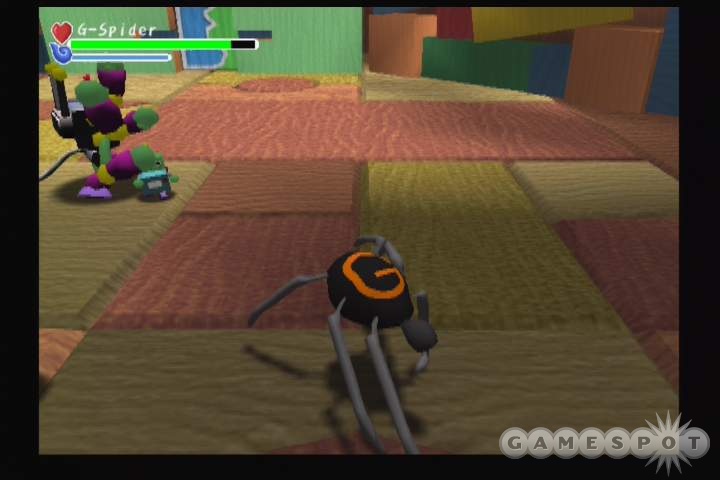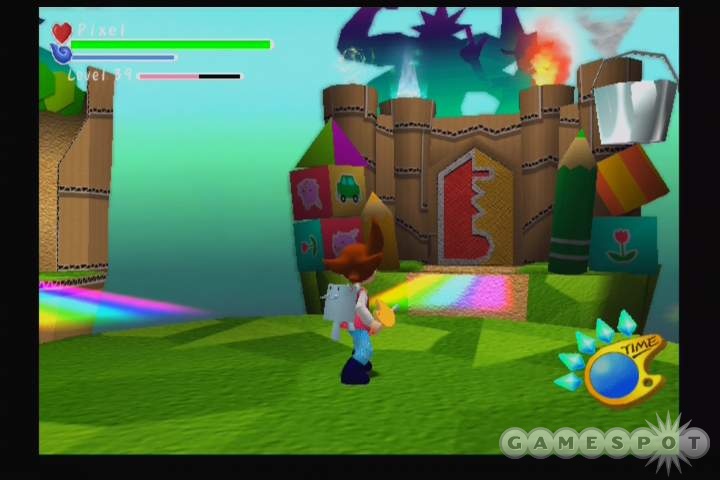Graffiti Kingdom is a pseudo-sequel to Magic Pengel, a creature-battling game released in 2003. Like Magic Pengel, Graffiti Kingdom lets you create your own unique creatures to use in battle, but this time around the draw mode is much more robust and lets you create just about any kind of creature you can imagine in full 3D. Graffiti Kingdom does have a story mode, with some basic 3D platforming and fighting, as well as some light puzzles. However, the story is just tacked on to give you a playground in which to test out your creations. The action in Graffiti Kingdom is brief and shallow, but creating and animating your own crazy creatures is easy and rewarding enough to make up for it.

The story in Graffiti Kingdom is set up like your basic fairy tale. Long ago, a demon started wreaking havoc in Canvas Kingdom for some reason. To purge this evil from the land, powerful warriors were imbued with "graffiti" magic. Graffiti in this kingdom isn't quite the same as the stuff you might find on storefronts and bathroom stalls. Here, graffiti is simply a magic way of painting something and bringing it to life. It also refers to a kind of spiritual energy that can be channeled for a variety of purposes, such as conveniently sealing away demons. So, after the magic warriors sealed away the demon, time passed, and eventually graffiti magic was either forgotten or relegated to legends. Prince Pixel, an adventurous young boy with nothing better to do, stumbles upon a magic seal and unwittingly opens it, allowing the demons to spill into Canvas Kingdom once again, where they enslave all of Pixel's friends and family. The guardian of the seal is Pastel, a box dog with the voice of a little girl. Pastel teaches Pixel how to use the magic of graffiti, and together they set off to vanquish the demons and return Canvas Kingdom to the way it was.
The adventure takes Pixel through three distinct worlds, each broken up into several smaller stages. Each world has a mid-boss and a greater boss you must defeat to obtain a key to gain access to the master demon's room. The stages have underlying themes; for example, there's an underwater area, a fire and ice stage, and even a stage where you can race miniature cars on a bowling alley. The stages are large, but they're broken up into a series of rooms, usually containing a few characters you need to defeat to open up the path to the next room. There are some platforming sections, but the greater focus is on the fighting, which is simple and repetitive. The entire story mode takes only about four hours to complete, but it's fun to come back to since you can create your own creatures to bring with you into battle.
Thanks to the magic of graffiti, you can make Pixel transform into a graffiti character on the fly with a press of a button. When you defeat an enemy, you'll often collect its devil card, which lets you transform into that creature once you assign it to a direction on the D pad. You can take up to three graffiti creatures at a time into battle, and you can swap those out at any of the frequent save points scattered throughout each level. There are dozens of rare, and special cards you can collect in the game, but if that isn't enough, you can create your own graffiti creatures as well.
Graffiti Kingdom features a simple but fairly deep 3D draw mode that lets you flex your creative muscle and create an army of unique creatures to fit any situation. Once you give a creature a shape, you can assign it various attacks, such as punches, kicks, and tackles. As you defeat enemies and earn experience, you level up, which doesn't make you more powerful, but it does unlock a variety of new and useful features in draw mode. For example, when you reach a certain level you can give a creature wheels or new special moves. If you don't feel like creating your own creature from scratch, you can edit any of the existing creatures to modify their attack, add a body part, or just change their color scheme. It's really addictive to see what you can come up with, and the creatures you create are limited only by your own imagination. Pretty much anything you create can be made useful given the right attacks and moves, from a simple bouncing blob to a giant hot dog with arms, or wings even--it's pretty much up to you. It takes only a few minutes to create a simple creature, but you can spend hours on a single creation if you have the patience and ambition to get really detailed.
Once you've created some creatures, you can use them in story mode, or you can pit them against a friend's creatures in two-player tournament mode. You can each take up to three creatures into battle to fight it out in one of four stages. The stages are small, and some of them feature environmental hazards, such as lava pits. This makes for a frantic button-mashing style of play that is fun for a while but quickly wears thin, despite the custom creatures.
The game has a unique visual style that is somewhere between Katamari Damacy and those old Claymation Christmas specials. The stages are bright and colorful, with huge objects in vivid primary colors. The characters follow suit, and they range from giant rainbow-colored bears to police cars and even the Taito logo. The look of the game is definitely charming, but unfortunately the frame rate drops severely when there are more than a couple of enemies onscreen. It's also difficult to see the action because the camera is terrible in Graffiti Kingdom. You can press L1 to snap the camera behind your character, and you can move the camera around your character with the right analog stick. However, the frantic movement of many of the characters makes it difficult to see what's going on around you. Oftentimes a boss will come out of nowhere and hit you as you're trying to move the camera so you can see where the boss is.

The sound in Graffiti Kingdom is cutesy and appropriate, but it can get annoying at times. Some of the characters make noises every time they attack, which means you hear the same grunt or squeak over and over again. The characters are all fully voiced in all the story sequences, and some are better than others. Even the bad ones aren't annoying, and in fact they're kind of endearing in a way. The music sounds like something you'd hear at a carnival, with heavy use of accordions and xylophones to keep things upbeat. Like the rest of the sound in the game, the music isn't particularly good or bad, but it goes well with the look and feel of the rest of the game.
Graffiti Kingdom is basically 3D modeling software with a simplified interface and a barely-there story to give it some context. Despite the lackluster action and brief story, Graffiti Kingdom is definitely entertaining for anyone with even the slightest flicker of creative ambition.